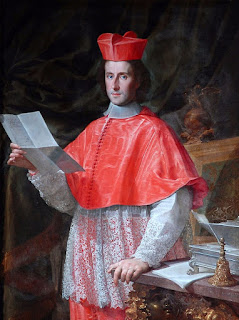Venetian cardinal spent fortune on composers and painters
 |
| Francesco Trevisiani's portrait of Cardinal Pietro Ottoboni, painted in around 1689 |
Despite a somewhat licentious lifestyle that reportedly saw him father between 60 and 70 children, Ottoboni, whose great uncle was Pope Alexander VIII, was considered a candidate to succeed Pope Clement XII as pontiff following the death of the latter on 6 February.
However, he developed a fever during the conclave and had to withdraw. He died three weeks later.
Born into a noble Venetian family, Ottoboni was the last person to hold the office of Cardinal-nephew, a tradition dating back to the Middle Ages that allowed a pontiff to appoint members of his own family to key positions. The practice was abolished by Alexander VIII’s successor, Pope Innocent XII, in 1692.
Ottoboni was also made vice-chancellor of the Holy Church of Rome, a position he held until his death, which gave him an annual income that would have been the equivalent today of almost £5 million (€5.79m). Although he had several positions of responsibility, including superintendent general of the affairs of the Apostolic See, and governor of the cities of Fermo and Tivoli, he was an unashamed seeker of sensual pleasure.
This translated into a considerable number of mistresses but also a great love of music, in the pursuit of which he spent lavishly and, despite his wealth, managed to run up substantial debts.
 |
| Arcangelo Corelli's career flourished with Pietro Ottoboni's financial support |
Operas by Alessandro Scarlatti, Antonio Caldara and many other leading composers were premiered at the Cancelleria. Ottoboni supported Arcangelo Corelli, the greatest violinist of his generation, and worked with the German musician and composer George Frideric Handel for a period early in the 18th century.
His relationship with Corelli was such that when the musician died in 1713 he left his entire estate to the Cardinal, who in turn distributed it among Corelli’s family and arranged for him to buried at the Pantheon in Rome, his tomb marked with an elaborate memorial.
Other composers who had Ottoboni to thank for the advancement of their careers included his fellow Venetians Antonio Vivaldi and Tomaso Albinoni.
Ottoboni’s patronage extended beyond his own theatre. He was also the major benefactor of what is now the Accademia Nazionale di Santa Cecilia, Italy’s premier conservatory, and the Accademia Filarmonica di Bologna.
 |
| The cover of the libretto for Scarlatti's 'The Martyrdom of St Cecilia' |
Beyond the world of music, the Sicilian architect Giovanni Battista Vaccarini, who became one of the most prominent figures in the Sicilian Baroque movement that grew after the earthquake of 1693, and painters Sebastiano Conca, Sebastiano Ricci and Francesco Trevisan also benefited from his support. The Seven Sacraments, which he commissioned in 1712 and was executed by Giuseppe Maria Crespi, is now in the Museum of Dresden in Germany.
Ottoboni was a collector of art as well as a sponsor, yet much of his vast collection was lost to Italy when he died, as a result of his debts, which demanded that his possessions be sold and the proceeds shared among his creditors.
Among his 530 paintings, some of which he inherited from his great uncle but many that he bought himself over half a century, included works by Guido Reni, Tintoretto, Pietro da Cortona, Jacopo Bassani, Giuseppe Cesari and Paolo Veronese. They were disposed of in four sales and have consequently been distributed around the world.
 |
| The Palazzo della Cancelleria in Rome was Cardinal Ottoboni's home as vice-chancellor of the Holy Roman Church |
The Palazzo della Cancelleria, which was Cardinal Ottoboni’s residence in Rome, is situated between Corso Vittorio Emanuele II and the Campo de' Fiori. It is probably the earliest Renaissance palace to be built in Rome, designed by the architect Donato Bramante and constructed between 1489 and 1513, initially as a residence for Cardinal Raffaele Riario, who was treasurer of the Holy Roman Church under Pope Sixtus V, and subsequently evolved as the seat of the Chancellery of the Papal States. It was also used as the parliament building by the short-lived Roman Republic in the mid-19th century.
 |
| Rome's ancient Pantheon is the burial place of many famous individuals, including Arcangelo Corelli |
Considered to be Rome’s best preserved ancient building, the Pantheon, which can be found in Piazza della Rotonda, was built in AD 118 on the site of a previous building dating back to 27 BC. It was consecrated as a church in the seventh century and many important people are buried there, including the kings Victor Emmanuel II and Umberto I, and Umberto’s wife, Queen Margherita, and the writers Voltaire, Rousseau, Victor Hugo and Émile Zola.
More reading:
How Arcangelo Corelli influenced the development of music
Why Alessandro Scarlatti was ahead of his time
Vaccarini's legacy to the city of Catania
Also on this day:
1792: The birth of composer Gioachino Rossini
Home










